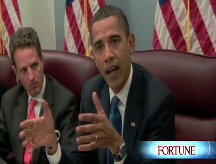Stimulus: Stuck on cars
Critics say spending focuses too much on highways and not enough on public transport.
 |
| Critics say stimulus spending needs to get out of the car and onto the train. |
NEW YORK (CNNMoney.com) -- A major chunk of the stimulus plan dealing with transportation is drawing fire for focusing too much on building new highways and not enough on regular maintenance projects and public transport.
The House has budgeted $30 billion for roads and bridges and $10 billion for mass transport as part of a $550 billion spending plan designed to boost the economy.
Supporters of the plan say most of that money will be spent on repair, and that such projects can be allocated quickly to jolt the economy. But critics say the plan short-changes public transportation, focusing too much on the types of mega-highway projects that got the nation into its energy and environmental mess in the first place.
"This is a pretty big disappointment," Robert Puentes, a fellow with the Brookings Institution's Metropolitan Policy Project, said of the plan. "There was all this momentum for some kind of reform, but when you look at what's in there, it just doesn't do that."
Puentes said with ridership at record levels, more money should have been allocated for public transportation, perhaps double the current amount.
He also said there should have been stronger language in the bill directing states to use the money for repair projects instead of for new construction projects.
Repair projects can put people to work quickly, while avoiding the construction of vast new highways that might not mesh with the nation's goal of cutting greenhouse gasses, he said.
Also, the money should be allocated to serve the most people. Peuntes said that under current funding formulas, places in an around cities - which account for two-thirds of the population - will only get 11% of the money. Basically, we can expect more bridges to nowhere.
But Puentes' allegations are contentious. Tony Dorsey, a spokesman for The American Association of State Highway and Transportation Officials, said the funding is based on the size of the state, and that it's a formula that's been refined by Congress over the years and works well.
Moreover, Dorsey said the sates will use this money to fund maintenance and repair projects that they were already considering, but couldn't carry out due to budget shortfalls.
"There won't be earmarks," he said. "These are fix-it-first kind of projects, projects that have to get done."
It hard to say who's right.
An analysis of projects submitted by about half the states done by U.S. PIRG, an advocacy organization founded by former green party candidate Ralph Nader, showed states plan on spending 60% of the stimulus money on new construction projects.
Building America's Future, a coalition of state and local officials to promote infrastructure development, also says more money should be spent on public transport and called for a greater emphasis on repair projects.
But the group stopped short of requiring states to spend the money on repair and transit projects only, saying it would be very difficult to do politically.
Politics has obviously been the driving force behind the whole funding process.
Building American's Future said they wanted a bill similar to a proposal by House Transportation and Infrastructure Committee Chairman Jim Oberstar. That recommended over $14 billion in funding for public transport projects.
A spokesman for the infrastructure committee said the money was eventually reduced because the House leadership and the White House were "trying to balance a large number of national needs and interests in fashioning a bill that would get bipartisan support."
The spokesman added that most members on the committee are still happy infrastructure spending in general is being funded at such a high amount. ![]()



